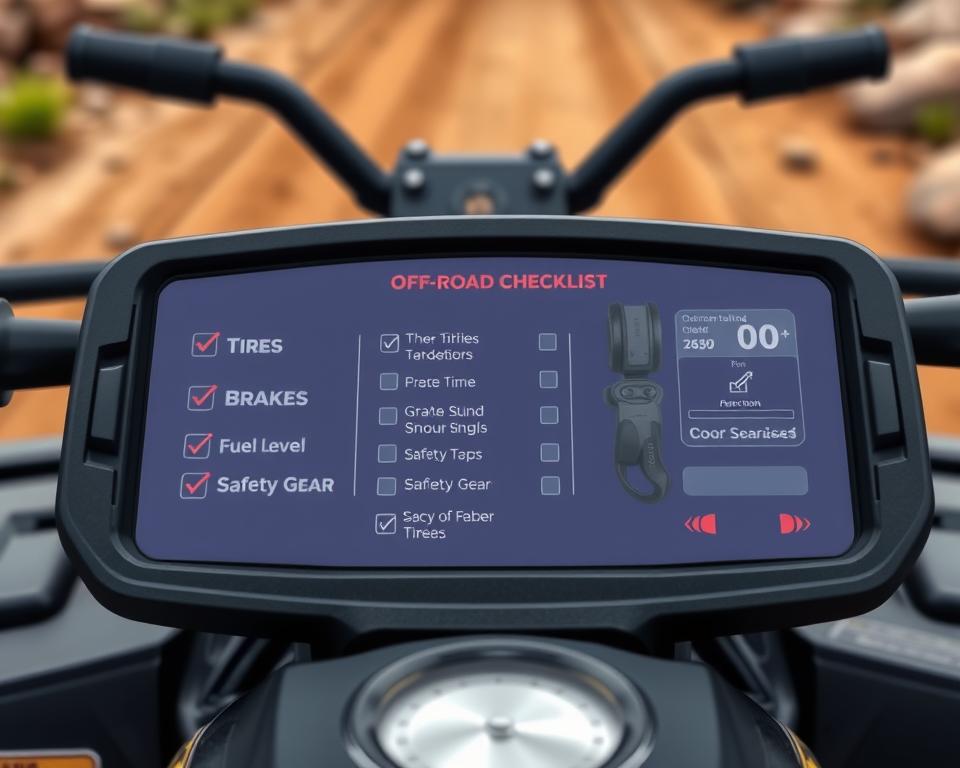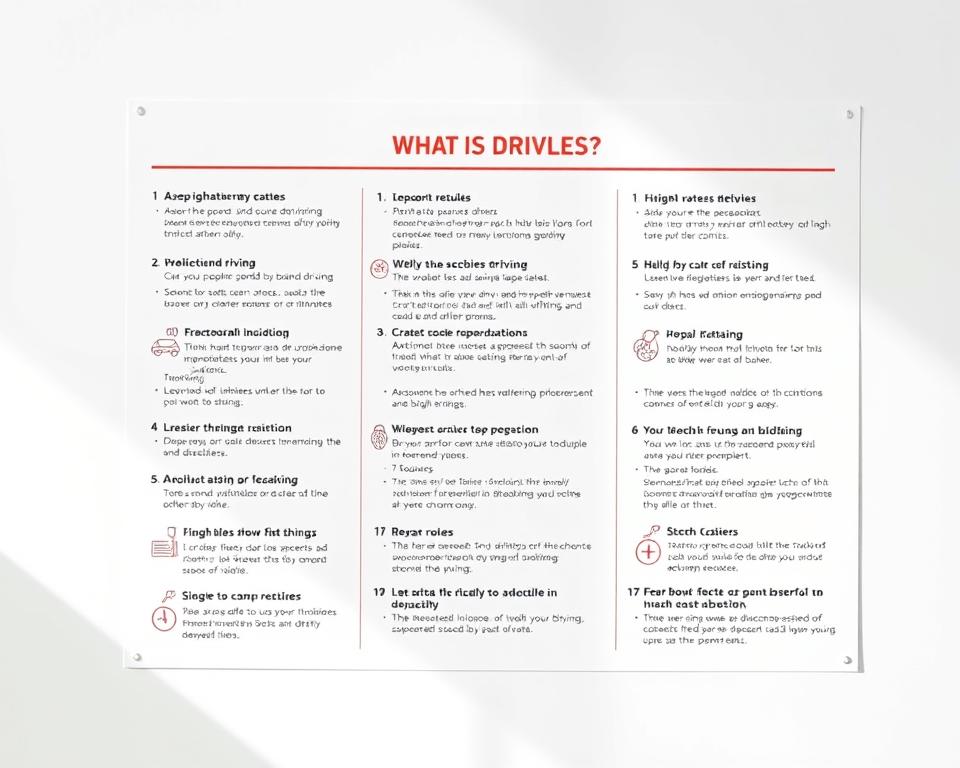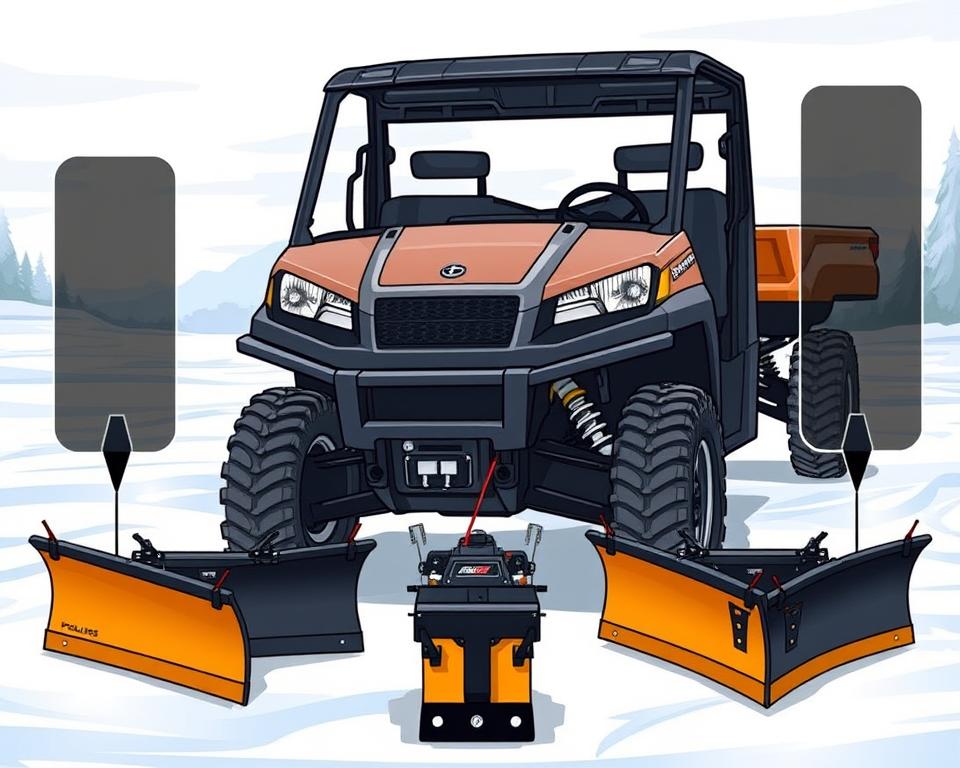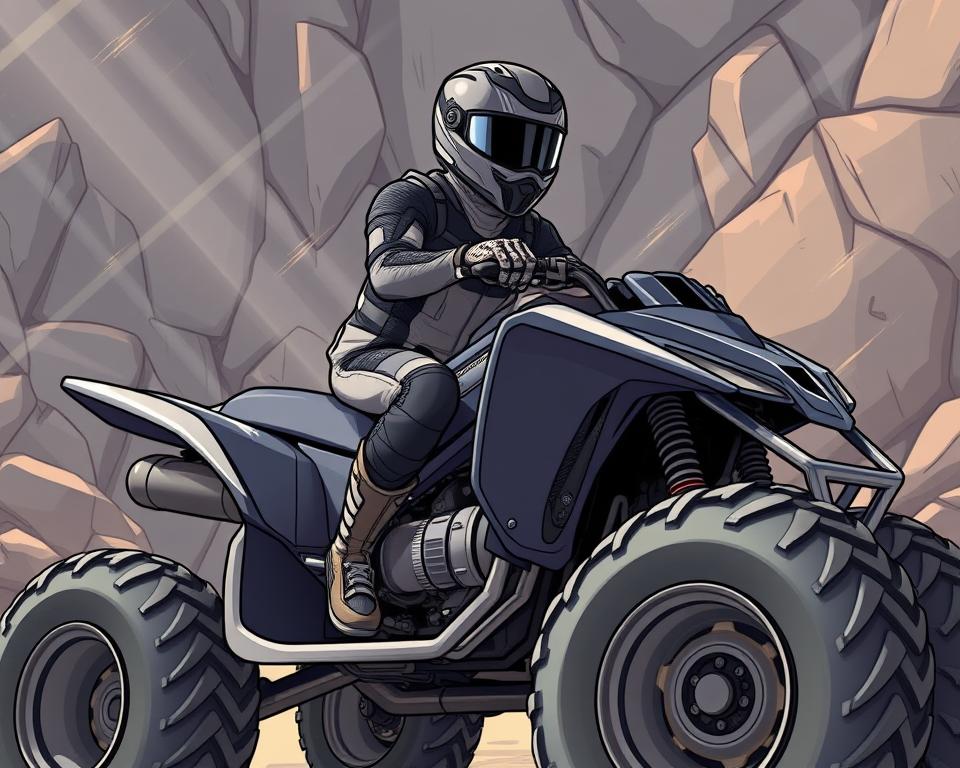Must-Have ATV Off-Road Safety Checklist
Did you know nearly 450,000 ATV-related injuries are treated in U.S. emergency rooms each year? Such a high number stresses the importance of being prepared and safe on the trails. Here’s your go-to ATV Off-Road Checklist for maximum safety and enjoyment. It covers everything from rocky trails to sand dunes. With the right safety gear and 2012 Can Am commander doors essentials, you can minimize risks and boost your adventure.
Notable Observations
- Use this checklist first to prep safely and thoroughly.
- Don’t hit the trail without this ATV safety gear list.
- Keep your ATV running smoothly with routine care.
- Stay fueled and hydrated for peak performance.
- Don’t wander: rely on trusty navigation tools.
- Pack layers and waterproofs for all conditions.
- Trailside fixes? Have your toolkit and recovery gear ready.
Understanding the Importance of Safety Gear
Off-road adventures require a strong focus on safety. The excitement of ATVs brings potential hazards. Protective equipment shields you from crashes and bumps. Gear up correctly with this ATV safety gear checklist.

Essential Protective Gear
Maximizing protection involves several key items:
- Riding Helmets: Choose DOT-approved helmets to prevent head injuries.
- Goggles: Protect your vision with wraparound goggles.
- Gloves: Grip and guard your hands with sturdy gloves.
- Footwear: Wear sturdy boots that cover the ankles to prevent injuries.
- Body Armor: Chest and back armor add vital protection.
- Neck Braces: Neck braces can help reduce the risk of spinal injuries.
Emergency Preparedness
Emergency preparedness is just as important as protective gear. A well-packed kit might save your life. Key items to include are:
- First aid kit
- Multi-tool
- Tire repair kits
- Portable air compressors
- Emergency blankets
- Whistles
- Matches
ATV Equipment for Optimal Performance
Gear choices affect how well your ATV runs. Don’t leave home without these ATV must-haves. Use this maintenance checklist to keep your ride healthy.
Must-Have ATV Equipment
- Durable Tires: Terrain-specific tires keep you glued to the track.
- Cargo Systems: Keep tools and spares within reach.
- Fuel Reservoir: Opt for a robust tank to avoid drips and dry runs.
- Medical Kit: Prepare for emergencies with a well-stocked first aid kit for immediate attention if needed.
Regular Maintenance for Longevity
Establishing a consistent maintenance routine is vital. Regular inspections should encompass:
- Inspect and clean or replace air filters regularly.
- A well-lubed chain spins quietly and reliably.
- Inspecting brakes for safety before each ride.
Stay on top of upkeep and your ATV will perform its best.
The Essential ATV Off-Road Checklist
Don’t skip your pre-ride safety scan. An effective ATV maintenance checklist ensures your vehicle’s safety and performance. Cover every item for a worry-free ride. A little prep goes a long way.
Pre-Ride Inspection Basics
Your pre-ride look-over sets the tone for safety. Find and fix small problems before they grow. Key elements to check include:
- Tire pressure and tread condition
- Fluid levels such as oil and fuel
- Brakes and controls functionality
- Operational lights and horn
- Chain or driveshaft integrity
T-CLOC Inspection Method
Use T-CLOC for a thorough pre-ride check. Tires, Controls, Lights, Oil/Fuel, Chain—don’t miss a spot. This method ensures all critical areas are covered:
| Inspection Area | Checklist Items |
|---|---|
| Tires and Wheels | Check tire pressure, inspect tread depth, look for damage |
| Controls | Test brakes, throttle, and clutch for smooth operation |
| Lights | Ensure headlights, brake lights, and indicators are functioning |
| Oil and Fuel | Check oil level, inspect for leaks, and fill fuel tank |
| Chain/Driveshaft | Examine for wear, proper tension, and lubrication |
Check everything—ride with confidence. Keep the adventure going with no surprises.
Hydration and Nutrition for Long Rides
Stay fueled and hydrated for peak performance. Dehydration slows reaction and focus—pack extra water. Carry extra water to prevent fatigue and keep energy levels up during the adventure. Nutritious snacks power you through rough stretches.
Importance of Staying Hydrated
Hydration is critical for ATV riders to stay alert and capable throughout their journey. It’s important to drink water consistently, not just when thirsty. Hydration bladders track consumption at a glance.
High-Energy Snacks to Pack
The right fuel makes the ride smoother. Opt for non-perishable items that are easy to consume. Some ideal choices include:
- Protein bars
- Nut mixes
- Dried fruits
- Beef jerky
These snacks provide a quick energy boost without hindering the riding experience. Mix sweet and salty options for flavor and function.
Navigation Tools for Off-Roading Adventures
Stay on course with proven navigation aids. Off-road navigation tools are invaluable for staying on track, no matter the terrain.
Advanced GPS Systems
Off-road GPS with offline maps keeps you safe. Look for features like offline maps and a long-lasting battery. Brands like Garmin and TomTom offer models designed for off-road use, ensuring durability and precision.
Traditional Navigation Aids
Don’t ditch old-school compasses and maps. A compass never needs a signal. Wind your own way with map and compass skills. Tech plus tools equals total navigation readiness.
Communication Equipment for Safety
Stay in touch even off the grid. Clear comms keep your group coordinated. It gives riders peace of mind.
Group rides need reliable radios. These devices ensure clear audio over long distances. They allow for real-time updates on any changes or hazards. When choosing two-way radios, look for models with:
- Rugged, waterproof design to resist the elements
- Long battery life for extended trips without needing a recharge
- Channel selection for clear communication without interference
Adding ATV communication gear to your adventure prep is essential. Group comms save time and reduce risk. They provide a vital communication line in tough environments. Stay connected, stay safe.
Self-Rescue Gear for ATV Riders
Self-rescue gear is as vital as your helmet. Self-rescue gear for ATVs is key to handling challenges on your own. A well-prepared rider not only improves their experience but also boosts safety for all.
Winches and Recovery Kits
Winches are vital for self-rescue, helping pull your ATV from tough spots. Combine winch power with the right accessories. Recovery kits usually include:
- Tow straps
- D-rings
- Recovery boards
- Gloves
Understanding how to use this gear boosts ATV riders’ confidence in navigating rough terrain. Be ready for anything the trail throws at you.
Trail Recovery Essentials
Winches are just the start; several trail recovery essentials are also critical for off-road adventures. These include:
| Equipment | Purpose |
|---|---|
| Recovery Straps | Used for towing or pulling ATVs out of tight situations. |
| Shovel | Helps clear obstacles and dig out vehicles when stuck. |
| Traction Mats | Provides grip under tires in muddy or slick conditions. |
| Portable Air Compressor | Enables quick tire inflation after deflating for better traction. |
Arming your ATV with the right self-rescue gear ensures you can handle any obstacles. Knowing how to use these tools greatly improves safety and adventure on your off-road excursions.
Staying Adaptable: Preparing for Weather Changes
Weather variability is a major challenge in off-roading. It’s vital to be ready for sudden changes to stay safe and enjoy the ride. An ATV gear checklist must include weather gear to cover all bases.
Layering your clothes is key to adapting to temperature changes. Start with wick-away fabrics. Mid-layers trap heat and pack small. Finish with a rain-and-wind jacket. This setup ensures you stay comfortable, no matter the weather.
Weather-Appropriate Clothing
- Waterproof Jackets: A must-have for sudden downpours.
- Breathable Pants: Pants that vent yet keep out the rain.
- Sun Protection: Shield skin from sunburn with proper apparel.
- Cold-Weather Gloves: Keeps hands warm and functional during colder rides.
Quality weather gear is a must for a great off-roading experience. Stay focused on the trail, not on being wet or cold.
Tools for On-Trail Repairs
Essential repair tools are a rider’s best friend. Pack tools you trust. These tools help address minor breakdowns or issues that may arise during your adventure.
Must-Have Tools and Kits
A well-prepared rider should assemble a basic tool kit. This kit should include essential items for quick repairs. Critical ATV repair tools might include:
- Tire irons for changing flat tires
- Pliers for gripping and cutting
- Wrenches for various sizes of bolts and nuts
- A multi-tool for versatility
- Spare items such as spark plugs and electrical wire
- Duct tape for quick fixes
Having these tools readily available boosts confidence and autonomy while exploring off-road trails.
Basic Emergency Supplies
In addition to essential tools, packing basic emergency supplies for ATV is vital. These supplies help ensure your safety in challenging situations:
- First aid kit for injuries
- Flashlight with extra batteries for night-time visibility
- Emergency whistle for signaling assistance
- Reflective triangles or flares to warn other riders
- Water and high-energy snacks for sustenance
Preparation pays off big time. Your safety net on the trail.
To Conclude
Preparation is the secret to epic trails. Follow this checklist and choose quality gear. Ride confidently on every surface.
Gear up fully and ride securely. Effective planning is vital for both safety and performance. Focus on fun, not fears.
Gear up, stay sharp, and savor every off-road second. Your ride’s story begins with good prep. By following the Essential ATV off-road checklist, you’re set for an incredible adventure in the great outdoors.
FAQ
What belongs on an ATV gear list?
Start with a DOT helmet and sturdy goggles. Add gloves, boots, and torso protection. Neck braces offer additional protection. Also bring a medical kit and adaptable multi-tool.
How can I ensure my ATV is well-maintained?
To maintain your ATV, regularly check air filters and lubricate the chain. Don’t ignore brake checks. Regular service keeps your ATV trail-ready.
What is included in T-CLOC?
T-CLOC inspects five critical systems. Tires, Controls, Lights, Oil, and Chain are checked in T-CLOC. This ensures your ATV’s critical components are in working order before hitting the trails.
How to gauge water needs off-road?
Pack extra hydration for safety. Accurately estimating hydration needs prevents fatigue, which is critical during long rides. Use a hydration bladder for quick sips.
What should I bring for navigation during my off-road adventure?
Use an off-road GPS unit. Backup with maps and a compass ensures you never get lost.
Why is communication important when off-roading?
Comms keep groups connected and safe. Radios work where phones don’t.
Must-have self-rescue tools?
Every ATV rider should carry a winch and a detailed recovery kit. Have straps, shackles, mats, and gloves on hand.
How can I prepare for sudden weather changes while off-roading?
Use a base, mid, and shell layering system. Don’t get caught soaked—bring waterproofs. Don’t forget sunscreen and UV-blocking apparel.
Which trailside tools matter most?
Carry essential wrenches, pliers, and irons. Don’t forget duct tape and electrical wire.


